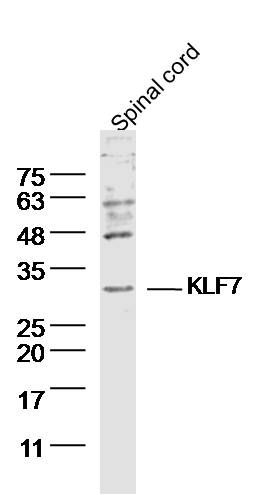KLF7 Polyclonal Antibody
Purified Rabbit Polyclonal Antibody (Pab)
- SPECIFICATION
- CITATIONS
- PROTOCOLS
- BACKGROUND

Application
| WB, IHC-P, IHC-F, IF, ICC, E |
|---|---|
| Primary Accession | O75840 |
| Reactivity | Rat, Pig, Dog, Bovine |
| Host | Rabbit |
| Clonality | Polyclonal |
| Calculated MW | 33 KDa |
| Physical State | Liquid |
| Immunogen | KLH conjugated synthetic peptide derived from human KLF7 |
| Epitope Specificity | 131-210/302 |
| Isotype | IgG |
| Purity | affinity purified by Protein A |
| Buffer | 0.01M TBS (pH7.4) with 1% BSA, 0.02% Proclin300 and 50% Glycerol. |
| SUBCELLULAR LOCATION | Nucleus. |
| SIMILARITY | Belongs to the krueppel C2H2-type zinc-finger protein family. Contains 3 C2H2-type zinc fingers. |
| Important Note | This product as supplied is intended for research use only, not for use in human, therapeutic or diagnostic applications. |
| Background Descriptions | KLF7 is a transcriptional activator that belongs to the Krüppel C2H2-type zinc finger protein family. KLF7 targets promotor regions bearing CACCC elements in order to regulate transcription. It is believed that KLF7 is an important element for regulation of differentiation and the development of nervous systems. Specifically, increased expression of KLF7 is associated with neuronal precursors exiting the cell cycle and beginning to differentiate. Overexpression of KLF7 can lead to cell cycle arrest and a decrease in DNA synthesis. Also, KLF7 is thought to regulate the expression of Trk A, the receptor for nerve growth factor, which is required for the normal growth and maturation of neurons. KLF7 is a widely expressed protein with highest expression found in brain and nervous tissue. |
| Gene ID | 8609 |
|---|---|
| Other Names | Krueppel-like factor 7, Ubiquitous krueppel-like factor, KLF7 (HGNC:6350) |
| Target/Specificity | Ubiquitous and highly expressed in brain and spinal cord in the adult, and in kidney and brain in the embryo. |
| Dilution | WB=1:500-2000,IHC-P=1:100-500,IHC-F=1:100-500,ICC=1:100-500,IF=1:100-500,ELISA=1:5000-10000 |
| Storage | Store at -20 ℃ for one year. Avoid repeated freeze/thaw cycles. When reconstituted in sterile pH 7.4 0.01M PBS or diluent of antibody the antibody is stable for at least two weeks at 2-4 ℃. |
| Name | KLF7 (HGNC:6350) |
|---|---|
| Function | Transcriptional factor (PubMed:16339272, PubMed:9774444). Plays a critical role in neuronal morphogenesis and survival of sensory neurons (By similarity). Represses the corneal epithelium differentiation (PubMed:28916725). Also acts as a metabolic regulator, by modulating insulin sensitivity in pancreatic beta cells and skeletal muscle cells (PubMed:16339272). Inhibits transcriptional inducers of adipogenesis and has a repressive role in the expression of several adipokines, including leptin (PubMed:16339272). |
| Cellular Location | Nucleus. |
| Tissue Location | Widely expressed. |

Thousands of laboratories across the world have published research that depended on the performance of antibodies from Abcepta to advance their research. Check out links to articles that cite our products in major peer-reviewed journals, organized by research category.
info@abcepta.com, and receive a free "I Love Antibodies" mug.
Provided below are standard protocols that you may find useful for product applications.
If you have used an Abcepta product and would like to share how it has performed, please click on the "Submit Review" button and provide the requested information. Our staff will examine and post your review and contact you if needed.
If you have any additional inquiries please email technical services at tech@abcepta.com.













 Foundational characteristics of cancer include proliferation, angiogenesis, migration, evasion of apoptosis, and cellular immortality. Find key markers for these cellular processes and antibodies to detect them.
Foundational characteristics of cancer include proliferation, angiogenesis, migration, evasion of apoptosis, and cellular immortality. Find key markers for these cellular processes and antibodies to detect them. The SUMOplot™ Analysis Program predicts and scores sumoylation sites in your protein. SUMOylation is a post-translational modification involved in various cellular processes, such as nuclear-cytosolic transport, transcriptional regulation, apoptosis, protein stability, response to stress, and progression through the cell cycle.
The SUMOplot™ Analysis Program predicts and scores sumoylation sites in your protein. SUMOylation is a post-translational modification involved in various cellular processes, such as nuclear-cytosolic transport, transcriptional regulation, apoptosis, protein stability, response to stress, and progression through the cell cycle. The Autophagy Receptor Motif Plotter predicts and scores autophagy receptor binding sites in your protein. Identifying proteins connected to this pathway is critical to understanding the role of autophagy in physiological as well as pathological processes such as development, differentiation, neurodegenerative diseases, stress, infection, and cancer.
The Autophagy Receptor Motif Plotter predicts and scores autophagy receptor binding sites in your protein. Identifying proteins connected to this pathway is critical to understanding the role of autophagy in physiological as well as pathological processes such as development, differentiation, neurodegenerative diseases, stress, infection, and cancer.


